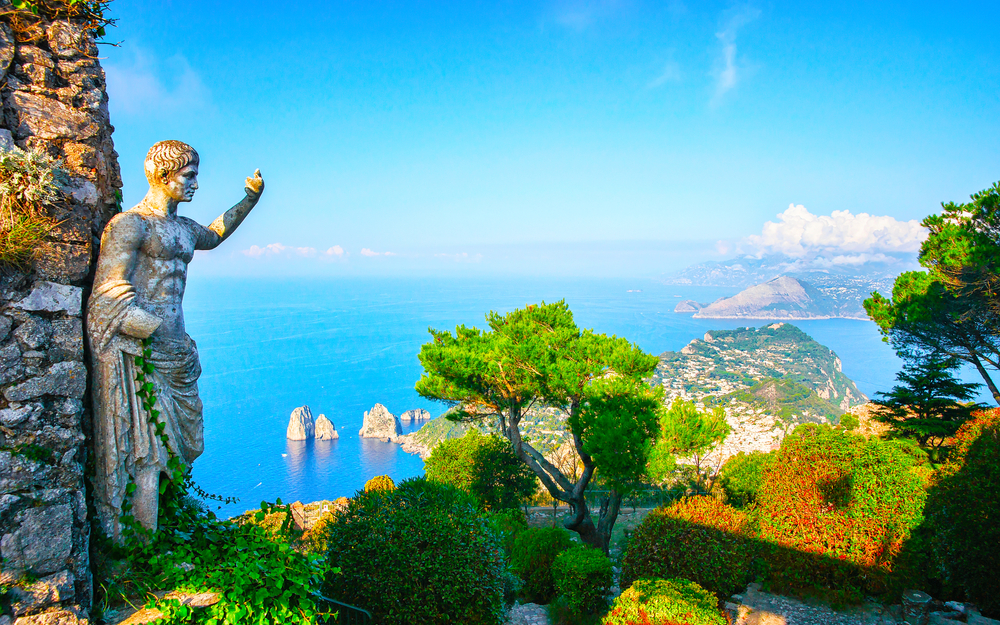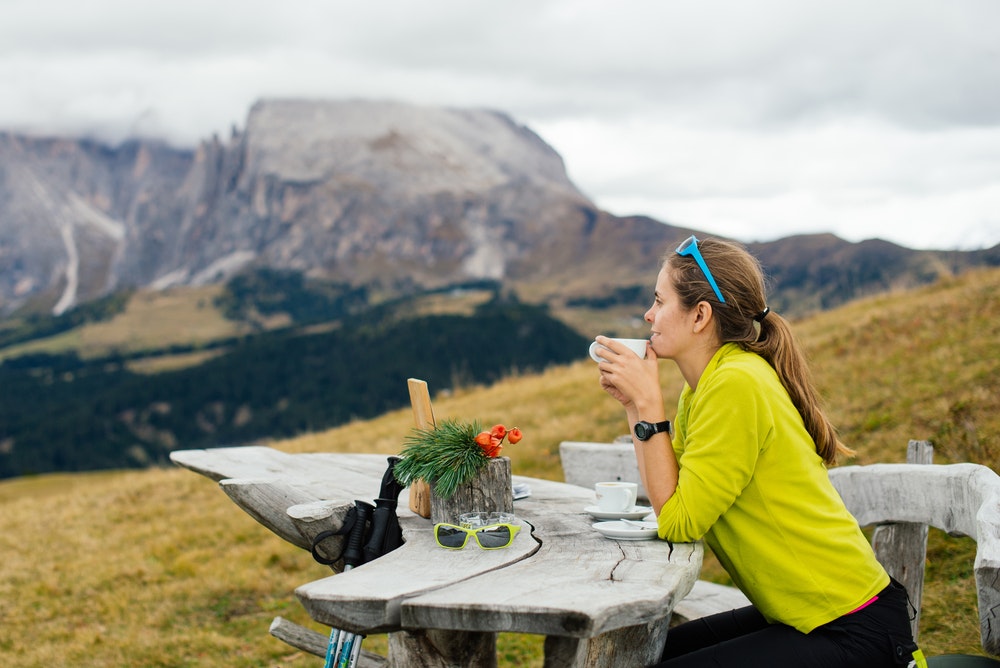Discover Italy
It would take a lifetime to see all of Italy’s magnificent buildings, palatial churches, and masterpiece-filled museums. Cultural and historical discoveries abound in Rome, Florence, and Milan while Venice sails its way into every traveler’s heart with its romantic canals filled with gondolas. The city-state of Vatican City marvels with its artistic treasures, gorgeous gardens, and reverent atmosphere. Renaissance artwork can be found in the most unexpected of places, and iconic art like Michelangelo’s David never fails to impress.
Active travelers will enjoy the opportunities to explore the outdoors. The natural landscape calls out to hikers who want to climb the Italian Dolomites in the northeast of the country while the rolling hills of Tuscany beckon wine lovers. Southern Italy’s dramatic Apennines Mountains juxtapose against the sunny seaside of Naples and the Amalfi Coast, with that perfect Mediterranean weather and golden sun that is so characteristic of the region. And right off Italy’s southern-booted coast lies the island of Sicily, known for its villages, vineyards, ancient temples, and beaches. And in-between visits at some of Italy’s ancient Roman ruins, travelers will relish in the flavors of the country, including fresh Mediterranean fish, pastas, cheeses, cured meats, wines, gelato, and more. With experiences to meet every traveler’s interest, it’s no wonder Italy is one of the world’s most-visited countries.
Planning a trip to Italy? Read on to find out when to visit, what to do, and more to make your vacation unforgettable.

What is the best time to visit Italy?
Depending on your interest will dictate the best time to visit Italy, but April—June is when the weather is best and not too hot, hiking trails are open, festivals are happening, and historical and cultural sites are open later—but crowds are very high. As summer progresses into July and August, the coastline fills up with locals looking to cool off, so beaches will be especially crowded. The shoulder season of September—November is cooler with less crowds, and it’s also harvest time, when summer’s wine grapes and produce are farmed from vineyards and fields from across the country. Skiers to the Alps will want to come in December—March when Alps skiing is at its best.
How can I get to Italy?
There are numerous direct flights to Rome’s Fiumicino Airport from major US cities. Boston, New York, Washington DC, Miami, Atlanta, Chicago, Philadelphia, Los Angeles, San Francisco, and Seattle all offer direct flights. Flight times from east coast cities will average about eight hours, nine hours from Chicago, and 12-13 hours from the west coast. United, Delta, and Alitalia are the three carriers that offer the most direct flights. Some airlines also fly into Milan’s Malpensa airport if you’re looking to bypass Rome.
How to get around in Italy?
Italy is very accessible. For those focused on visiting the main cities, Italy’s train system is excellent. Its high-speed rail connects the major cities to one another while local trains will take travelers to smaller towns and villages. If looking for more leisurely travel with some spontaneity, driving a car is a great way to explore off-the-beaten-track villages and admire the surrounding landscape. Budget travelers can opt for bus service, which will take them to most of the same places as trains but at a slower pace.
Do I need a visa to visit Italy?
US citizens do not need a visa for stays up to 90 days. Citizens of other countries should check with their local embassy for entry requirements.
How many days should I spend in Italy?
Travelers to Italy should budget no less than two weeks to see the main highlights of the country, which would include Rome, Florence, Venice, Naples, and Milan. However, even with a two-week period, it still would not be enough time to see everything—Italy has over 2,000 years of history to explore! Regardless of the number of days, the best way to see Italy is to prioritize what you want to see and build your trip around those experiences. For example, culture lovers might want to focus their time only in Rome and Florence while hikers might prefer spending their time only in the north where they can hike the Alps. Plan on more time if you want to explore some of the lesser-known towns or go further afield to places like Sicily.
What are the top 5 places to visit in Italy?
1. Rome
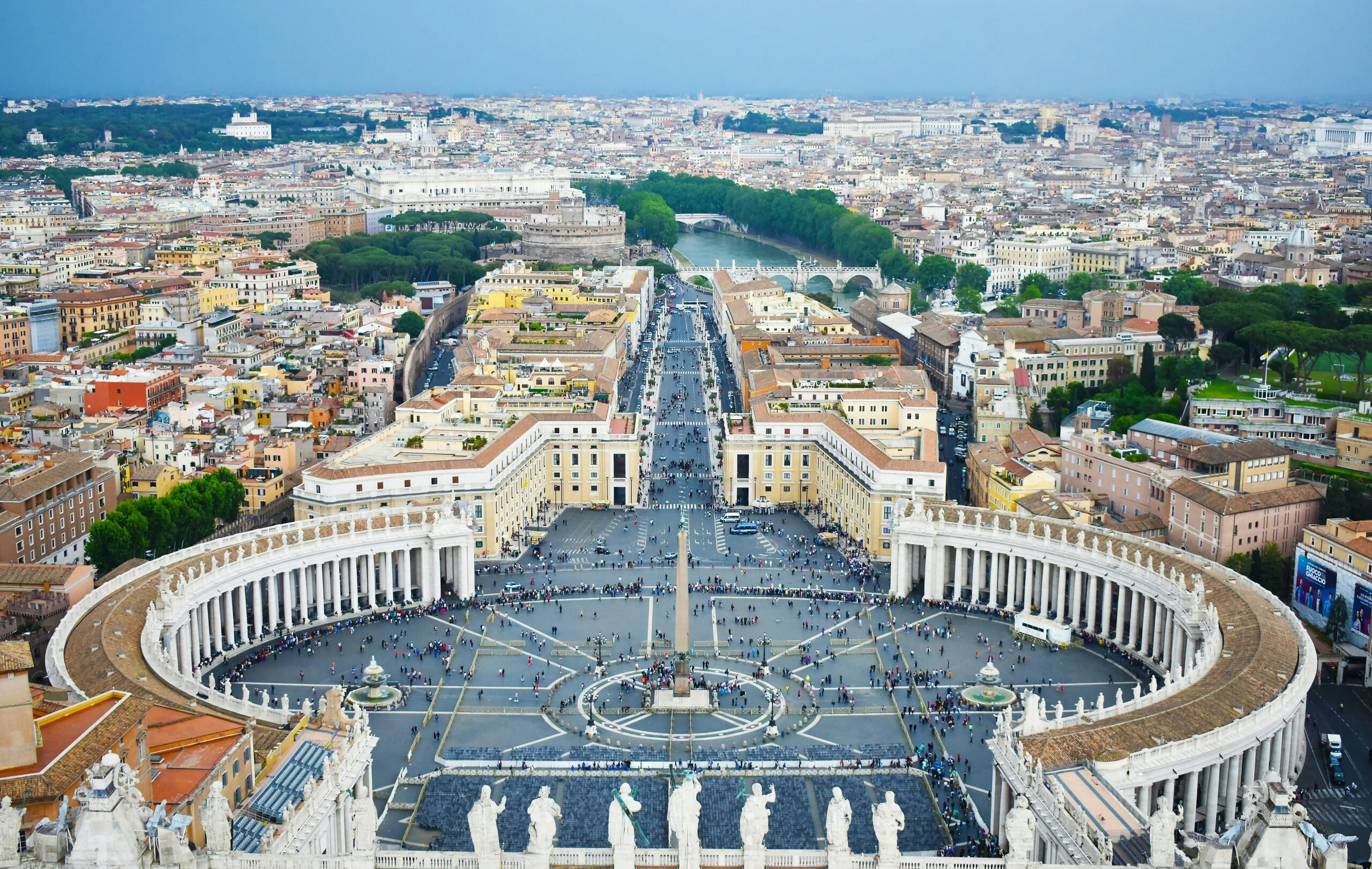
Traveling to Italy should always include time spent in Rome. The Italian capital is awash in history and art in its palaces, art museums, churches, and monumental ruins. Walking around its storied neighborhoods offers historical discoveries like coming upon the 4th-century Santa Maria church with its gilded mosaics or turning the corner to find yourself in one of Rome’s iconic piazzas like Piazza Navona. Some of Rome’s attractions are grandiose—the largest church in Christendom, the largest ancient amphitheater, the largest Roman triumphal arch—yet the city also hosts the smallest country in the world, Vatican City. With its stunning Sistine Chapel, Renaissance frescoes, statues, and tapestries, the Vatican astounds even the most jaded art lover. Stroll through the 2,000-year-old Roman Forum and the former Imperial palaces on Palatine Hill before throwing a euro for good luck in Trevi Fountain. Have an espresso in the shadow of the massive Colosseum before marveling at the Pantheon, Ancient Rome’s best-preserved temple. Then end each day enjoying freshly made pasta in one of the city’s storied cafes, followed afterwards by a glass of grappa and an evening stroll with gelato in hand.
2. Venice
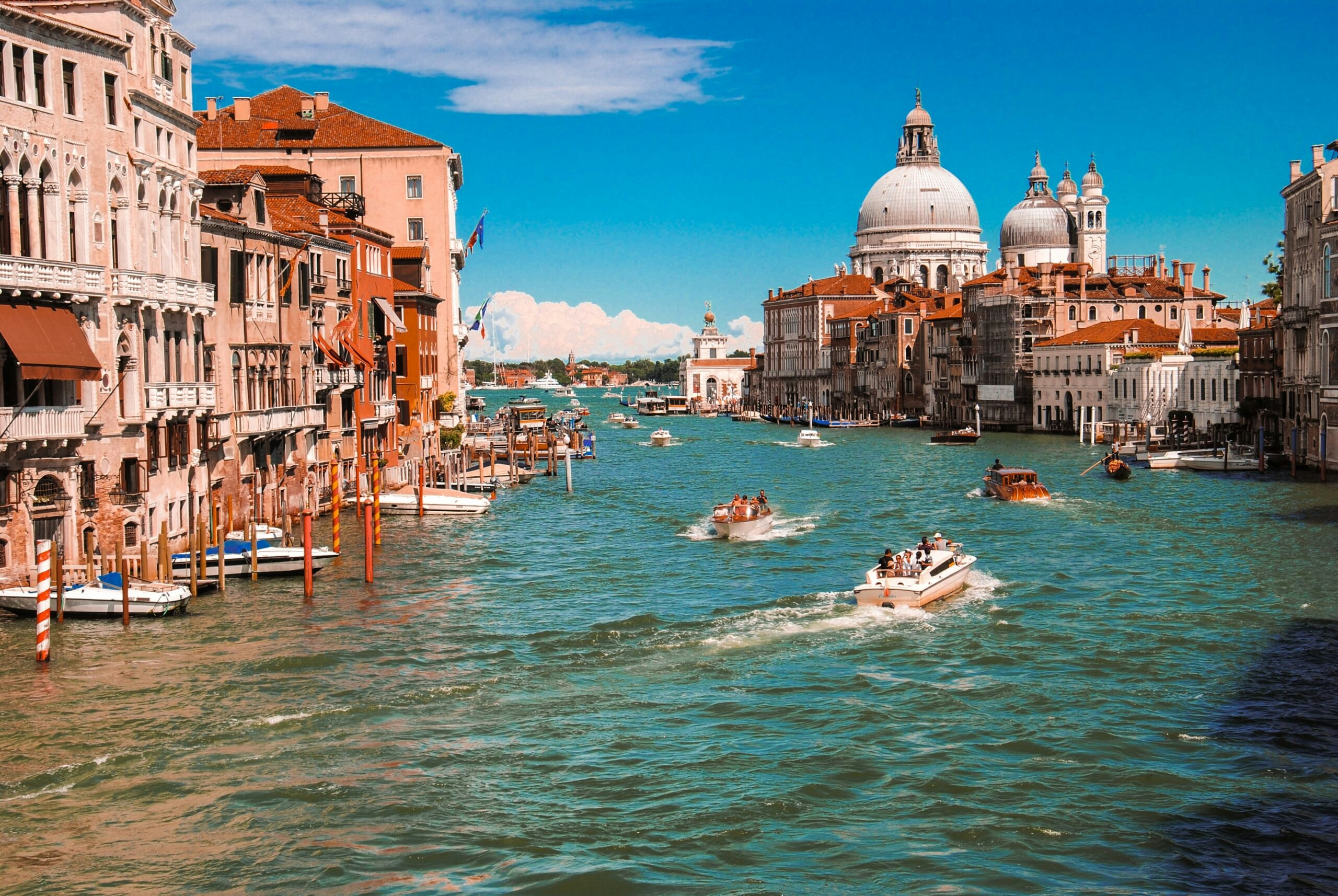
Venice is one of the most picturesque cities in Italy, with over five million travelers arriving every year to explore its series of winding canals and historic bridges, beautiful churches, fantastic art museums, and Gothic and Renaissance architecture strewn out over a series of six islands. Connected by narrow pathways, 150 canals, and 400 bridges, the city is walkable, but most travelers still opt for at least one ride on the gondolas that glide through canals lined with palaces. Some of the most visited sites are the beautiful St. Mark’s Cathedral with its gold Byzantine mosaics, the Gothic 14th-century Doge’s Palace, and Basilica di Santa Maria della Salute with its impressive dome and recognizable bell tower. The iconic 16th-century Rialto Bridge is one of Venice’s most recognized bridges as is the 17th-century Bridge of Sighs—the sighs refer to the prisoners who would “sigh” crossing it to their imprisonment. For excellent Grand Canal viewing the Ponte dell’Accademia bridge is a great spot to watch all the activity in the canal. Venice is also known for its colorful Carnevale festival, which takes place every February. During this annual festival, the city is full of pageantry and revelry, with people wearing masks and celebrating in the streets. Other iconic experiences include shopping for Murano glass, enjoying an espresso at Caffe Florian, (the oldest café in Italy), or enjoying a glass of wine at Harry’s Bar, the bar that invented the Bellini cocktail.
3. Tuscany
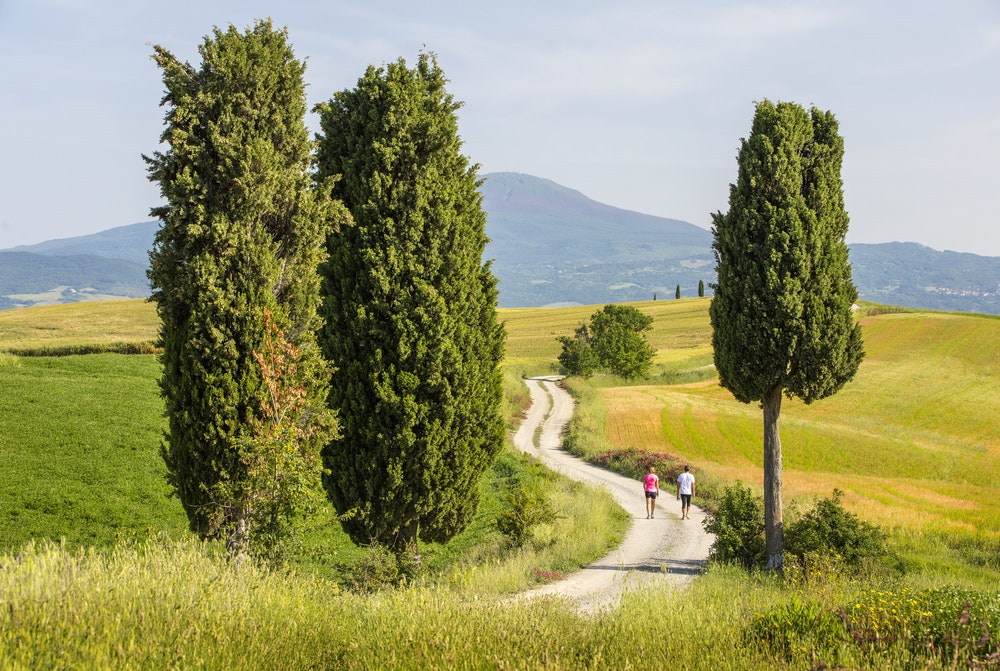
Situated 175 miles north of Rome lies Tuscany, the birthplace of the Renaissance and one of Italy’s most visited regions. Nestled in a landscape of rolling hills and picturesque views, are two of Italy’s art-filled cities—Florence and Siena. Florence can be pleasantly overwhelming, with its plethora of world-famous art and historic cathedrals like the Basilica di Santa del Fiore (also known as Duomo) or the Uffizi Gallery with its artwork from Renaissance masters Botticelli, Michelangelo, and da Vinci, to name just a few. Nearby is smaller Siena with its medieval Duomo di Siena, a beautiful cathedral with alternating stripes of green, white, and red marble and a façade decorated in statuary and mosaics. Its interior is even more impressive, filled with 172 busts from Jesus to Pope Lucius III and a floor inlaid with 56 marble panels depicting biblical themes. And if you have the time, only a day trip from Florence is Pisa, with its most well-known resident, the Leaning Tower of Pisa. Visitors will also be able to partake in some of Tuscany’s tasty red wines, including those made from the Sangiovese grape—otherwise known as “the blood of Jupiter.”
4. Campania and the Amalfi Coast
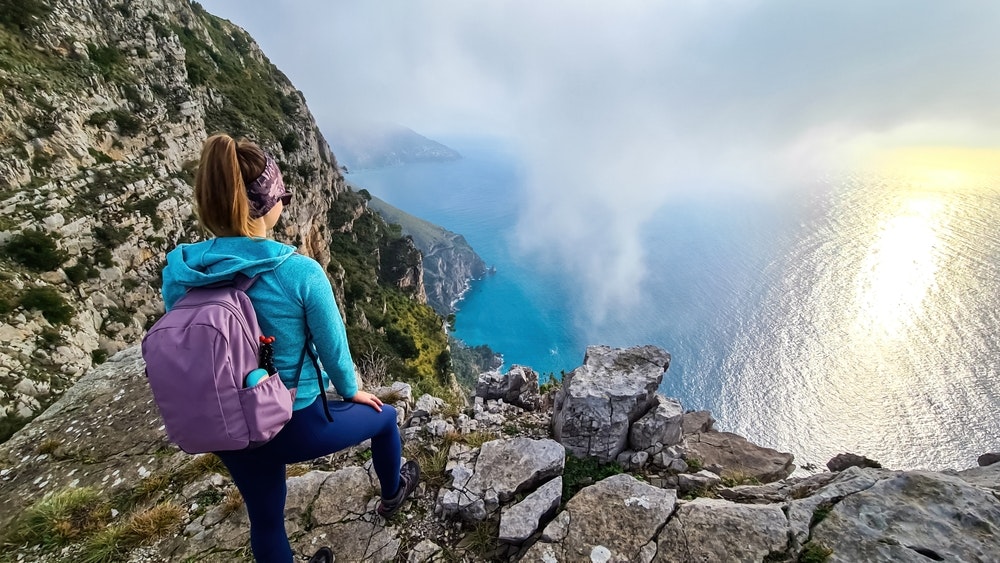
The Amalfi Coast is part of Italy’s romantic coastline. Located in the Campania region of Italy, it sits about 170 miles south of Rome and is popular for its beautiful beaches, seaside towns, and stunning cliffscapes. Its most picturesque towns—Positano, Amalfi, Sorrento, and Ravello—sit on the seaside cliffs and offer accessible beaches, stunning views of the Mediterranean, and charming local shops and cafes. The third largest city in Italy, Naples, is full of historic and cultural sites (and where pizza originated), while nearby Pompeii contains the region’s most famous ruins. It was here in 79 AD that Mount Vesuvius erupted suddenly, blanketing the area in volcanic ash, lava, and pumice that kept this ancient Roman city mostly intact. It offers a fascinating look at what daily life might have been like in ancient Roman times. New discoveries are still being found in Pompeii, and visitors can also tag on a hike up Mount Vesuvius itself.
5. Milan and Lake Como

Located in northwest Italy in the region of Lombardy, Milan is one of Italy’s most glamorous cities. Known for its focus on fashion and design, the city is full of high-end shopping, with some of Italy’s most recognized design houses calling Milan home, including Versace, Prada, and Armani. Besides its luxury shopping, the city has plenty of high-end eateries, but it’s what’s hidden away in the Santa Maria delle Grazie convent that is probably Italy’s most famous meal: Leonardo da Vinci’s “The Last Supper.” Nearby the convent and situated in the center of the city is Milan’s cathedral, Duomo di Milano. The city’s cathedral is one of the country’s most iconic, and despite being technically unfinished, it has a working sundial, 135 spires, and 4,000 statues—more than any other building in the world (see if you can find the sleeping dragon to the right of the central doorway). About 50 miles north of Milan lies Lake Como, Italy’s deepest lake, with over 100 miles of coastline and the most known of the five lakes that make up Italy’s Lake District. The lake sits up against the Italian Alps in a luxury resort area, surrounded by charming Italian villages, impressive villas, and gorgeous landscapes, and is a fantastic getaway for nature lovers, hikers, and those looking for a luxury escape.
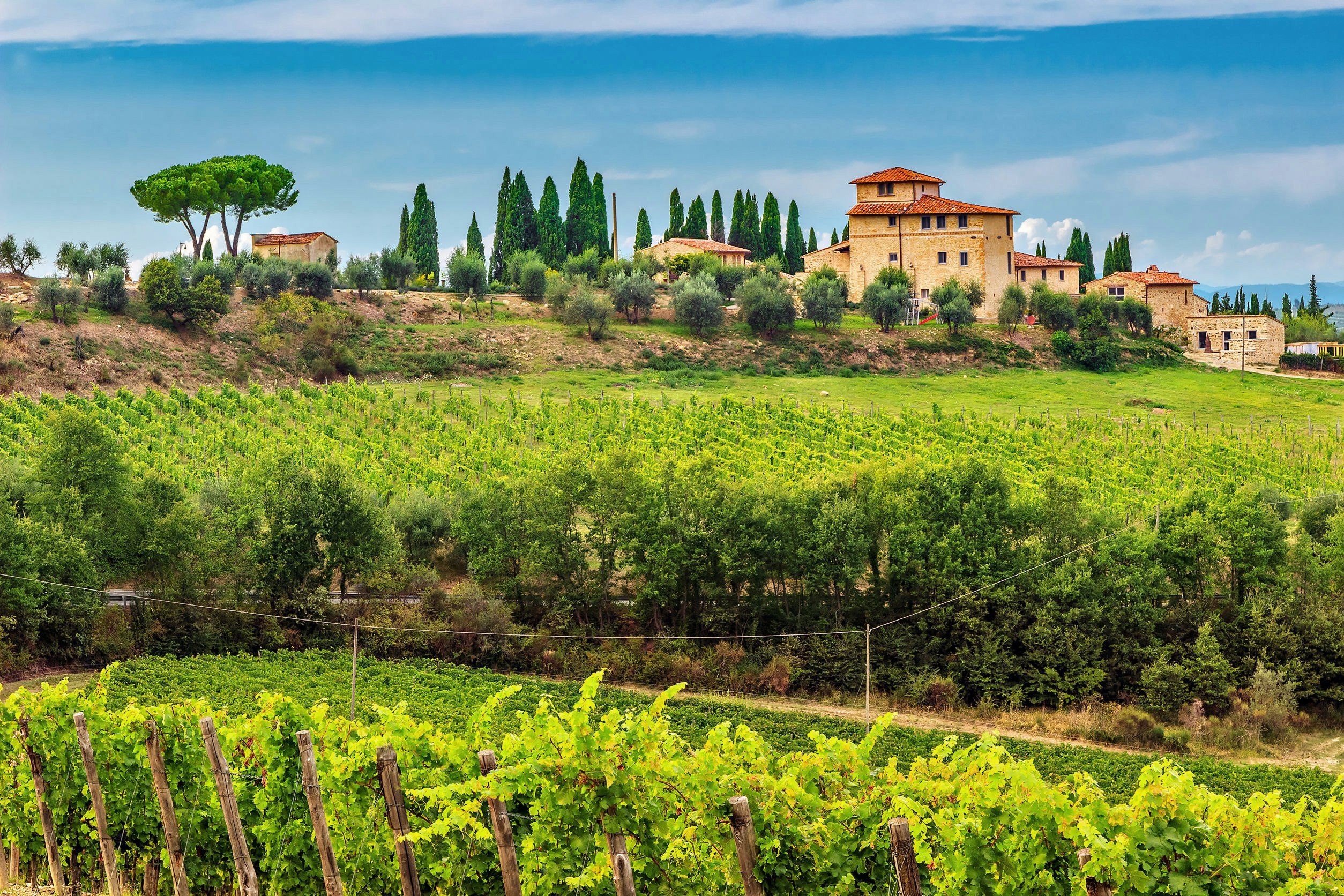
What are the best Italy adventure tours?
1. Italy Best of the Dolomites Hiking
Be dazzled by the monumental beauty of Italy’s Dolomites, with majestic pinnacles and fairy-tale spires, on this active Italian adventure. Each day you’ll follow scenic hiking trails up to ridges and mountain passes for spellbinding views, then descend to lush green valleys where wildflowers bloom in pastoral meadows. Along the way, you’ll pass grazing mountain goats and storybook villages as towering rock walls change color with the sun. From the Italian/Ladin village of Val di Fassa in Trentino to the Italian/German town of Alta Badia in South Tyrol, to the iconic Italian/Ladin town of Cortina in the Veneto region, you’ll cover all the must-see sites of this magnificent range, including the most famous peaks: Tre Cime di Lavaredo (9,839′) and Marmolada (11,024′). Experience the charm of mountain villages at comfortable hotels and dine on delicious local cuisine on this nine-day trekking adventure.
2. Italy Tuscany and Umbria Walking Tour

Discover the enchanting landscapes of central Italy on this delightful eight-day walking journey from the age-old vineyards and villages of Chianti to historic Siena, Pienza, and Bevagna. Savor the delicate aroma of wild lavender as you follow expert guides on lesser-known paths and feast on sumptuous farm-to-table fare prepared in traditional kitchens. In Umbria, Italy’s green and spiritual heart, you’ll move amidst artistic and architectural treasures, and follow in the footsteps of St. Francis of Assisi. Top it off with black truffles, fine wines, and nights at luxurious historic hotels.
View Italy Tuscany and Umbria Walking Tour
3. Italy Tuscany and Cinque Terre Walking Tour
Immerse yourself in two of Italy’s most enchanting regions on this perfectly paced nine-day walking adventure from Tuscany to the Italian Riviera. Follow scenic trails through Tuscan vineyards and cypress-dotted valleys, exploring historic hill towns, and sampling fine Chianti wines along the way. Marvel at the medieval wonders of Siena and San Gimignano with their ancient ramparts and towers. Then journey to Liguria’s spectacular coast to hike cliff-side paths that connect the Cinque Terre’s picturesque seaside towns. With fragrant lemon groves and stunning sea views, this is la dolce vita at its best.
4. Italy Sorrento Peninsula & Amalfi Coast Hiking Tour
The Italian region of Sorrento and the Amalfi coast is often called Campania Felix, “the fortunate land.” With mountains plunging into the sea and tiny colorful towns brimming with life in their embrace, there’s a spectacular sight at every turn on this movie-star coastline. Discover picture-perfect villages and take in the heady scents and colors of pure Mediterranean nature. Delight in stunning views from the top of Mount Faito, with Vesuvius in the distance. Explore the wondrous island of Capri and the remarkable archeological site of Paestum, an ancient Greek town. Starting and ending in Naples, this nine-day journey features stays in two perfectly located hotels, making it easy unwind in comfort. You also have the option to extend this trip with a visit to Pompeii.
5. Italy & Switzerland Heart of Gran Paradiso Hiking
Nestled between Italy’s Valle d’Aosta and Piemonte regions, Gran Paradiso National Park is a hidden treasure of the Graian Alps. Established in the 19th century to protect ibex, this haven for hikers and trekkers is home to Italy’s only peak above 13,000 feet. With high alpine meadows, larch forests, babbling brooks and mighty waterfalls, Gran Paradiso is a true gem. Join MT Sobek on this challenging trek that traverses the Graian Alps—a stunning crossroads between Italy and France. Each day, arrive at the trailhead for a full day of scenic hiking with long descents that lead back to cozy hotels in traditional alpine villages, providing you with warm hospitality and charming regional culture. Enjoy this eight-day adventure in the company of Mountain Travel Sobek’s incredible Alps guiding team including Laurent Langoisseur, Florence Simond, Beatrice Mugnier, Sebastian Gros, and Virginie Thomas.
6. Italy and Switzerland Lake District Hiking Tour
Experience the extravagant beauty of Italy and Switzerland’s Lake District on this idyllic eight-day hiking adventure. Starting at Lake Orta, tucked in the foothills of the alpine chain, visit tiny San Giulio Island before heading to the top of Monte Mottarone (4,895′). Follow scenic paths through forests and meadows above Lake Maggiore and Lake Lugano and take the pretty Wayfarer’s Trail around Lake Como. Along the way, discover picturesque islands and the Mediterranean charm of such lakeside towns as Bellagio, Varenna, and Orta San Giulio with its narrow cobblestone streets and pastel-washed houses. Savor hearty local gastronomy and sleep in the comfort of elegant 4-star hotels with stunning lake views.
7. Austria, Italy & Slovenia Alpe Adria Hiking Tour
Discover the highlights of the Alpe Adria, a 470-mile trail system from the Alps to the Adriatic Sea. From the highest summits down to lush valleys, past mountain lakes and aquamarine rivers, hike the trails’ most beautiful stretches. Experience memorable landscapes, rich cultures, and local cuisines of three different countries—Austria, Italy, and Slovenia—and encounter landmarks such as the Garnet Gate and mountaintop Sanctuary Monte Lussari. Wrap up your 10-day trip in the Italian town of Trieste, with dazzling Adriatic Sea vistas.
8. Croatia, Slovenia & Italy Village to Village Walking Tour

Food lovers will be rewarded with nine fulfilling days on spectacular trails on this active cultural and culinary journey. Trace Croatia’s Istrian Peninsula, Slovenia’s Julian Alps, and Italy’s Friuli-Venezia-Giulia region and discover an array of beautiful villages and towns including Rovinj, Bale, Motovun, Groznjan, Bled, and Montemaggiore. Discover the wonders of this trio of countries, experiencing rich historical settings and spectacular national parks on awe-inspiring hikes. Go wine tasting, learn how to hunt truffles, taste olive oil, and sample regional delicacies in the Mediterranean as you’ve never seen it before, far from the crowds. Unique hotels awaiting at the end of each day make for a dreamy finale.
View Croatia, Slovenia & Italy Village to Village Walking Tour
9. Alps Tour du Mont Blanc Hiking
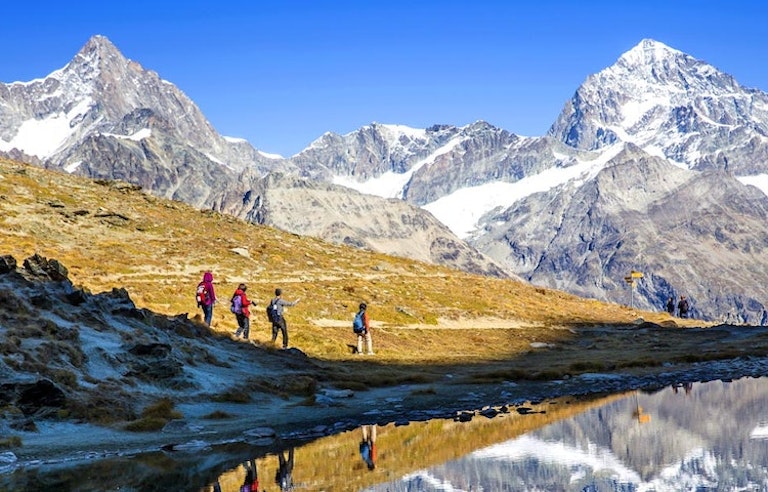
Mont Blanc. Europe’s highest and most iconic peak. Spectacular. Immense. Dazzling. And undisputedly on every serious hiker’s must-do list. Hiking for 10 days through the heart of the Alps won’t just get your pulse rate up, it will open your eyes to some of the most breathtaking vistas on Earth. Starting in the alpine village of Les Houches, near Chamonix, you’ll hike the full 99 miles around Mont Blanc. Follow age-old trails past giant glaciers, beside secret mountain lakes, and through grassy meadows — and delight in jaw-dropping landscapes at every bend. Experience three countries, cultures, and cuisines. Visit fairy-tale hamlets and enjoy warm alpine hospitality from the comfort of mountain accommodations. For those short on time, we also have an 8-day express version, the Alps Tour du Mont Blanc Express Hiking Tour.
10. Alps Tour de Monte Rosa Trek

Monte Rosa, “the Pink Mountain,” is the second-highest peak in both Western Europe and the Alps at 15,203 feet. Led by our expert hiking guides, embark on this nine-day adventure replete with conquests of majestic alpine peaks and passes. Starting in the village of Saas-Fee and finishing in Zermatt, at the foot of the Matterhorn, hike almost the complete circuit of the massif. Beneath cascading glaciers, through ancient hamlets and wildflower fields, take in vistas of Monte Rosa, and learn about Walser culture and tradition. Traveling through the Swiss canton of Valais to the Italian Piedmont and Valle d’Aosta, soak up heartfelt hospitality and enjoy restful nights at charming hotels.
Where are the best places to stay in Italy?
Accommodations in Italy vary depending on your budget and where you plan to stay. You can find everything from hostels and budget hotels to luxury resorts and apartments. Farm stays, convents, and monastery options are also available, and B&Bs can be found throughout the country. Airbnb is also an option in Italy, offering a variety of apartments and homes that might be better suited for families or large groups.
1. Grand Hotel Savoia: Cortina, Italy

This impeccable 5-star hotel in Cortina has an exclusive feel and provides guests with exceptional comfort and convenience. Your room has everything needed for a perfect stay: cozy fireplaces and matchless views of the Dolomites, designer furnishings and chic décor, minibar, flat screen TV, and free Wi-Fi. Concierge and room service are available, and the on-suite spa offers a retreat-like atmosphere with an indoor pool and sauna.
2. Palazzo Leopoldo Dimora Storica & Spa: Radda, Italy
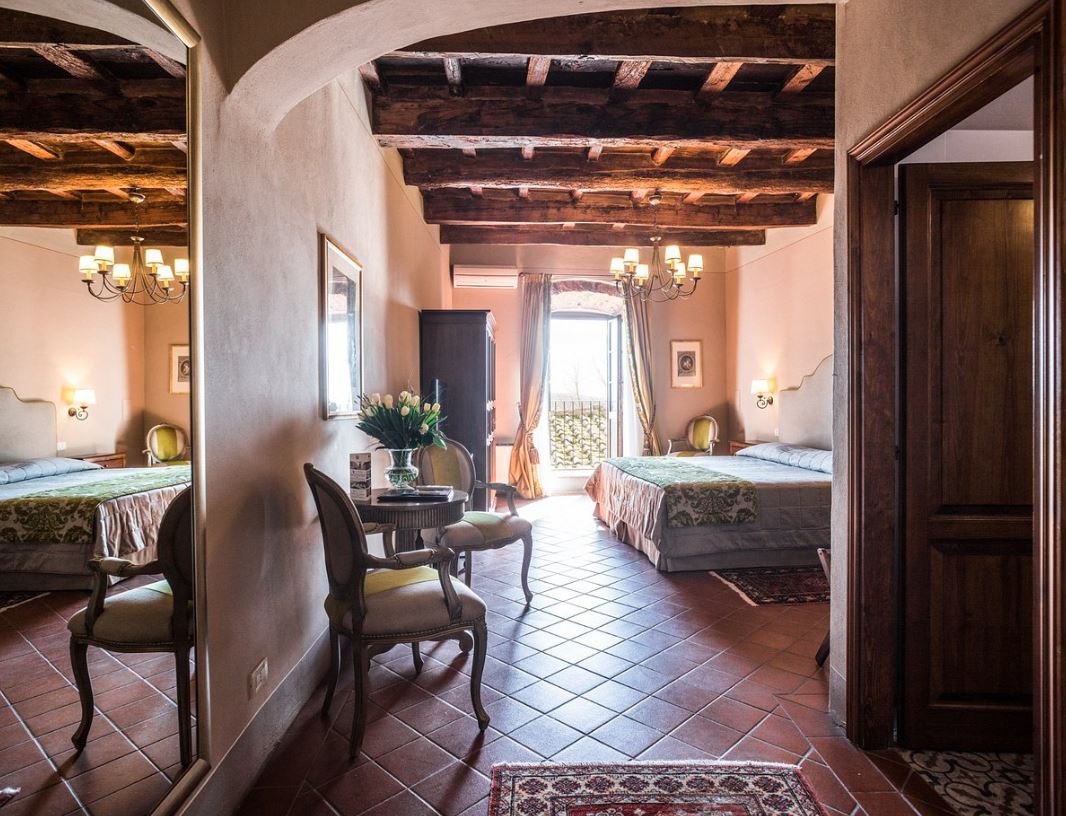
Experience old-world charm at the luxurious Palazzo Leopoldo, a converted manor house located in the historic town of Radda in Chianti. Plushly furnished rooms come with top-end amenities and the onsite spa offers a heavenly way to unwind. Clink glasses on the terrace as you soak in the scenic views of Chianti’s treasured vineyards.
3. Hotel Villa San Lucchese: Poggibonsi, Italy

Set in beautifully landscaped grounds, this elegant hotel offers down-to-earth guestrooms with free Wi-Fi, satellite TV, and safes. Some of the rooms have canopy beds, whirlpool tubs, exposed beams, and/or sitting areas. Other amenities include two outdoor pools, a tennis court, and a restaurant with a terrace. There’s also a landscaped garden, a library, and a bar, plus a wine cellar. Wine tastings and massage services are also available.
4. Hotel Villa San Lucchese: Poggibonsi, Italy

In a stone villa on a hillside overlooking the Ligurian Sea, this relaxed hotel has 12 cozy guestrooms offering minifridges, flat-screen TVs and free Wi-Fi, as well as balconies with sea views. Room service is available. Other amenities include a bar, a terrace, and an infinity pool, both with panoramic sea views.
Interesting Things to Know About Italy
- There are more UNESCO World Heritage Sites in Italy than anywhere else in the world, with 59 locations at last count. From city historic centers to frescoes, and volcanoes to hilly landscapes, Italy’s cultural and natural landmarks are stunning examples of Europe’s long history and Italy’s importance in it.
- Modern day pizza was invented in Italy. As far back as the 19th century, street vendors in Naples sold pizza slices to peasants as an inexpensive meal, but today’s pizza is said to have been invented by Naples chef Raffaele Esposito when he made pizzas for visiting royals King Umberto and Queen Margherita. One of the pizzas he made showcased the colors of Italy’s flag, with white mozzarella, green basil, and red tomatoes. Queen Margherita loved it so much that it was called Pizza Margherita and is still known by that name today.
- Italians drink 14 billion espressosa year—which might be an undercount. Italians love their espresso and will drink between 3-4 cups a day. They not only enjoy the jolt of caffeine, but espressos are a part of Italian culture and a way to step back from the day and reset oneself.
- Over 1M euros are thrown into Rome’s 18th-century Trevi Fountain every year. This 85-foot-high, 65-foot-wide fountain is one of Rome’s most visited landmarks. Local legend says that if you throw a coin into the fountain with your right hand over your left shoulder, it will bring you good luck—and ensure a future return to Rome.
- Italy is the world’s largest wine producer, making up almost 20% of the world’s wine. With its Mediterranean climate and long coastline, 20 different regions in Italy produce wine. Some popular Italian varietals include Pinot Grigio, Sangiovese, Chianti, and Muscat, but the country produces multiple varietals (21 at last count).
- Italy is home to 12 volcanoes, nine of which are still active, including the most active volcano in Europe. Italy’s volcanoes are some of the most well-known, including Mount Vesuvius outside Pompeii, Mount Stromboli on the Stromboli island near Sicily’s north coast, and Mount Etna in Sicily. Considered the “lighthouse of Europe,” Mount Stromboli has been continuously active for over 2,000 years, but the most active of Italy’s volcanoes is Mount Etna, erupting up to 200 times a year. Etna is also a UNESCO World Heritage Site and is the tallest active volcano in Europe at almost 11,000 feet.
What is the language in Italy?
Italian is Italy’s official language spoken by almost the whole country. A large percentage of the population also speaks a regional dialect in addition to Italian, and it’s estimated that almost one-third of the population speaks English.
What to eat in Italy?
Italy is a country that is just as well-known for its food as it is for its cultural and historical sites. Expect plenty of freshly made pasta and cured meats, fresh olives and Italian cheeses, and simple dishes like cacio e pepe (pasta with cheese and pepper, popular in Rome), pizza in Naples, or ossobuco (veal in vegetables, white wine, and broth). Expect breakfasts to be on the sweeter side, with a lot of Italians preferring a cornetto, a croissant-like pastry filled with something sweet like custard or jam. Lunchtime can last a couple hours and is usually the heaviest meal of the day, consisting of pasta or soup with a meat or fish dish to follow. Dinnertime starts around 8 pm and is similar to lunch but oftentimes lighter, with vegetables and fresh fruit also being served. After dinner, Italians like to have a digestivo, almost always alcoholic. Some popular after-dinner drinks include grappa (a type of Italian brandy), limoncello (a liqueur made from lemons), amaro (brandy with herbs), the anise-flavored sambuca, and the sweet liqueur amaretto.
What is the currency in Italy?
Like most of Europe, the currency used throughout Italy is the Euro, which makes it easier if you’re coming from another country in the EU. Major credit cards like VISA and Mastercard are accepted in most cities and towns, but always have euros in hand for when you come across local markets and small cafes in villages that don’t accept credit cards. You’ll also need bills less than 100 because smaller establishments can’t always make change for large bills.
What is the electricity in Italy?
The electrical current in Italy is 230 volts, 50 Hz. The plugs and sockets used in Italy are Type F and L. Check the voltage on your personal electronics chargers to determine if you need a voltage converter, but most US travelers will need a converter as US electronics are 110-120V (type A or B outlets). A good resource to see images of plug types is www.power-plugs-sockets.com.
What is the time zone in Italy?
The time zone in Italy is Central European Time (CET) Mean Time, which is six hours ahead of New York and nine hours ahead of California.
What to wear in Italy?
Generally, Italians dress nicer than Americans. Casual clothing should be simple and understated such as plain t-shirts, mid-length dresses, nice leggings, or a pair of khakis. When visiting churches or other religious sites, shoulders, stomachs, and knees must be covered so plan your outfit accordingly. If traveling in summertime, plan on wearing loose, breathable clothing to help keep you comfortable in the heat. Sunblock, sunglasses, and a hat are also strongly recommended as well as shorts for when you’re on the coast or not visiting churches (but only for daytime). For evenings out, a sports coast isn’t necessary except in the finer restaurants, but have a pair of nice shoes for dinner. If planning on hiking, pack layers you can take off and on as well as sturdy and comfortable hiking boots.
